2018 VOLVO XC60 T8 ECO mode
[x] Cancel search: ECO modePage 289 of 674
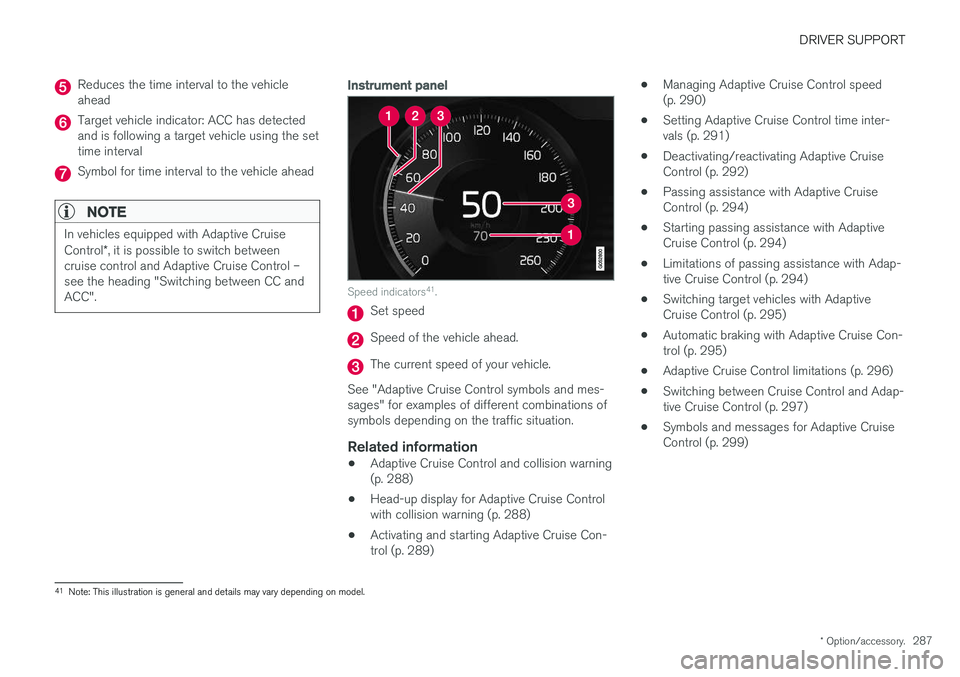
DRIVER SUPPORT
* Option/accessory.287
Reduces the time interval to the vehicle ahead
Target vehicle indicator: ACC has detected and is following a target vehicle using the settime interval
Symbol for time interval to the vehicle ahead
NOTE
In vehicles equipped with Adaptive Cruise Control*, it is possible to switch between
cruise control and Adaptive Cruise Control – see the heading "Switching between CC andACC".
Instrument panel
Speed indicators 41
.
Set speed
Speed of the vehicle ahead.
The current speed of your vehicle.
See "Adaptive Cruise Control symbols and mes- sages" for examples of different combinations ofsymbols depending on the traffic situation.
Related information
• Adaptive Cruise Control and collision warning(p. 288)
• Head-up display for Adaptive Cruise Controlwith collision warning (p. 288)
• Activating and starting Adaptive Cruise Con-trol (p. 289) •
Managing Adaptive Cruise Control speed(p. 290)
• Setting Adaptive Cruise Control time inter-vals (p. 291)
• Deactivating/reactivating Adaptive CruiseControl (p. 292)
• Passing assistance with Adaptive CruiseControl (p. 294)
• Starting passing assistance with AdaptiveCruise Control (p. 294)
• Limitations of passing assistance with Adap-tive Cruise Control (p. 294)
• Switching target vehicles with AdaptiveCruise Control (p. 295)
• Automatic braking with Adaptive Cruise Con-trol (p. 295)
• Adaptive Cruise Control limitations (p. 296)
• Switching between Cruise Control and Adap-tive Cruise Control (p. 297)
• Symbols and messages for Adaptive CruiseControl (p. 299)
41
Note: This illustration is general and details may vary depending on model.
Page 290 of 674

DRIVER SUPPORT
* Option/accessory.
288
Adaptive Cruise Control andcollision warning
Collision warning audible signal and symbol 42
.
Acoustic collision warning signal
Collision warning symbol
Camera/radar sensor distance monitoring
Adaptive Cruise Control utilizes approx. 40% of the vehicle's braking capacity. If a situationrequires more braking force than the AdaptiveCruise Control can provide, and if the driver doesnot apply the brakes, a warning light and audiblewarning signal will be activated to alert the driverthat immediate action is required.
WARNING
Adaptive Cruise Control only issues a warning for vehicles detected by its radar unit – thus, awarning may come after a delay or not at all.
• Never wait for a warning. Apply the brakes when necessary.
Related information
•
Adaptive Cruise Control
* (p. 285)
Head-up display for Adaptive CruiseControl with collision warning
In vehicles equipped with a head-up display *, a
flashing warning symbol will be displayed on the windshield.
Collision warning symbol on the windshield 43
.
NOTE
Visual warnings on the windshield may be dif- ficult to notice in cases of strong sunlight,reflections, extreme light contrasts, or if thedriver is wearing sunglasses or is not lookingstraight ahead.
Related information
• Adaptive Cruise Control
* (p. 285)
42
Note: This illustration is general and details may vary depending on model.
43 Note: This illustration is general and details may vary depending on model.
Page 293 of 674
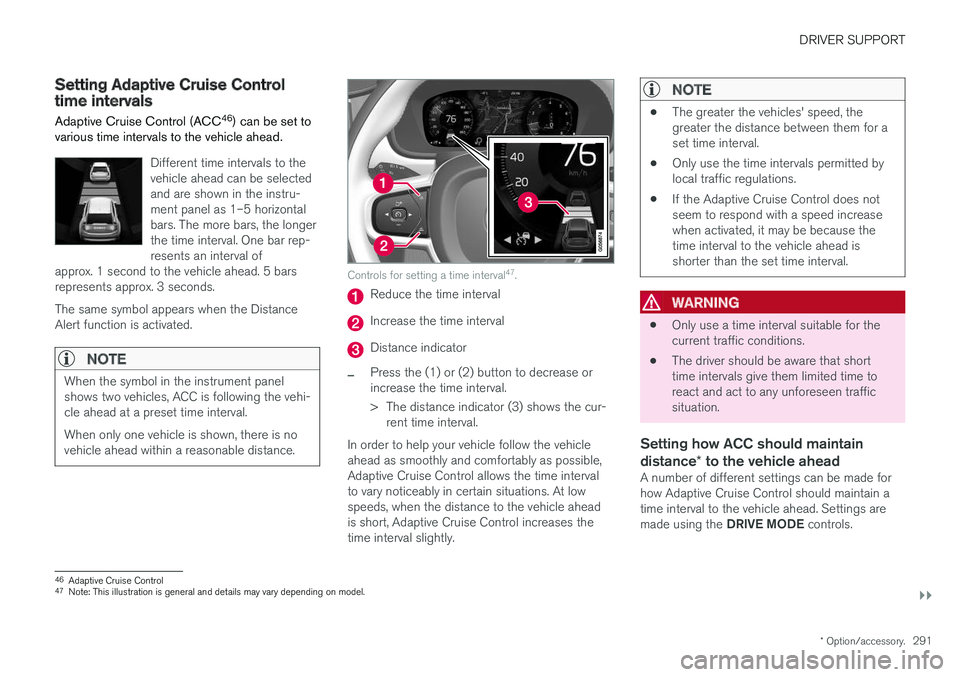
DRIVER SUPPORT
}}
* Option/accessory.291
Setting Adaptive Cruise Controltime intervals Adaptive Cruise Control (ACC 46
) can be set to
various time intervals to the vehicle ahead.
Different time intervals to the vehicle ahead can be selectedand are shown in the instru-ment panel as 1–5 horizontalbars. The more bars, the longerthe time interval. One bar rep-resents an interval of
approx. 1 second to the vehicle ahead. 5 barsrepresents approx. 3 seconds. The same symbol appears when the Distance Alert function is activated.
NOTE
When the symbol in the instrument panel shows two vehicles, ACC is following the vehi-cle ahead at a preset time interval. When only one vehicle is shown, there is no vehicle ahead within a reasonable distance.
Controls for setting a time interval 47
.
Reduce the time interval
Increase the time interval
Distance indicator
–Press the (1) or (2) button to decrease or increase the time interval.
> The distance indicator (3) shows the cur-
rent time interval.
In order to help your vehicle follow the vehicle ahead as smoothly and comfortably as possible,Adaptive Cruise Control allows the time intervalto vary noticeably in certain situations. At lowspeeds, when the distance to the vehicle aheadis short, Adaptive Cruise Control increases thetime interval slightly.
NOTE
• The greater the vehicles' speed, the greater the distance between them for aset time interval.
• Only use the time intervals permitted bylocal traffic regulations.
• If the Adaptive Cruise Control does notseem to respond with a speed increasewhen activated, it may be because thetime interval to the vehicle ahead isshorter than the set time interval.
WARNING
•Only use a time interval suitable for the current traffic conditions.
• The driver should be aware that shorttime intervals give them limited time toreact and act to any unforeseen trafficsituation.
Setting how ACC should maintain distance
* to the vehicle ahead
A number of different settings can be made for how Adaptive Cruise Control should maintain atime interval to the vehicle ahead. Settings are made using the DRIVE MODE controls.
46
Adaptive Cruise Control
47 Note: This illustration is general and details may vary depending on model.
Page 294 of 674
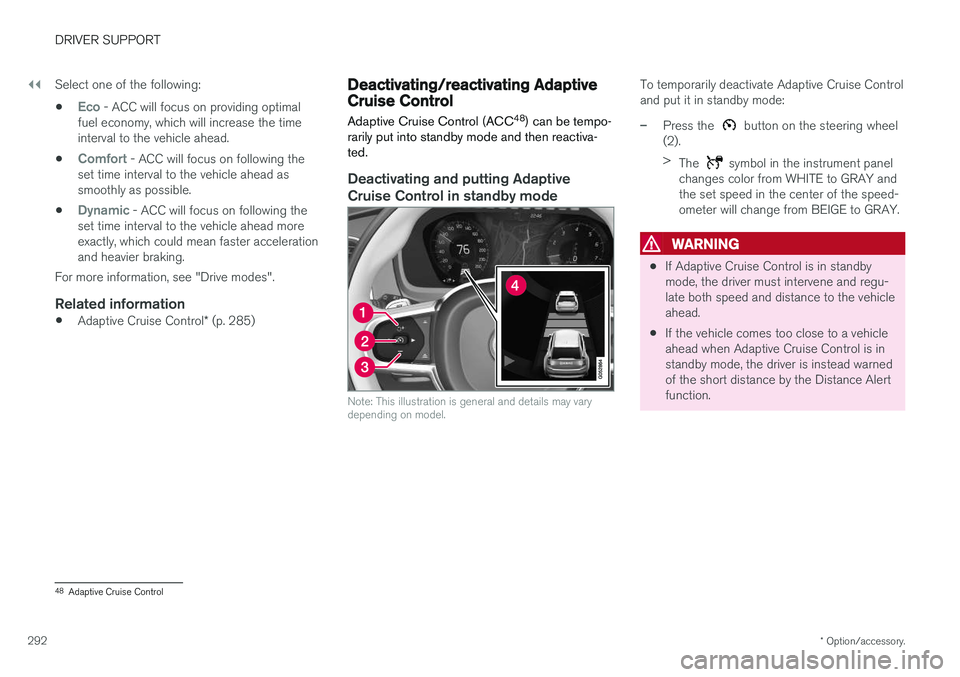
||
DRIVER SUPPORT
* Option/accessory.
292 Select one of the following:
•
Eco - ACC will focus on providing optimal
fuel economy, which will increase the time interval to the vehicle ahead.
•
Comfort - ACC will focus on following the
set time interval to the vehicle ahead as smoothly as possible.
•
Dynamic - ACC will focus on following the
set time interval to the vehicle ahead more exactly, which could mean faster accelerationand heavier braking.
For more information, see "Drive modes".
Related information
• Adaptive Cruise Control
* (p. 285)
Deactivating/reactivating AdaptiveCruise Control Adaptive Cruise Control (ACC 48
) can be tempo-
rarily put into standby mode and then reactiva- ted.
Deactivating and putting Adaptive Cruise Control in standby mode
Note: This illustration is general and details may vary depending on model.
To temporarily deactivate Adaptive Cruise Control and put it in standby mode:
–Press the button on the steering wheel
(2). > The
symbol in the instrument panel
changes color from WHITE to GRAY and the set speed in the center of the speed-ometer will change from BEIGE to GRAY.
WARNING
• If Adaptive Cruise Control is in standby mode, the driver must intervene and regu-late both speed and distance to the vehicleahead.
• If the vehicle comes too close to a vehicleahead when Adaptive Cruise Control is instandby mode, the driver is instead warnedof the short distance by the Distance Alertfunction.
48
Adaptive Cruise Control
Page 297 of 674
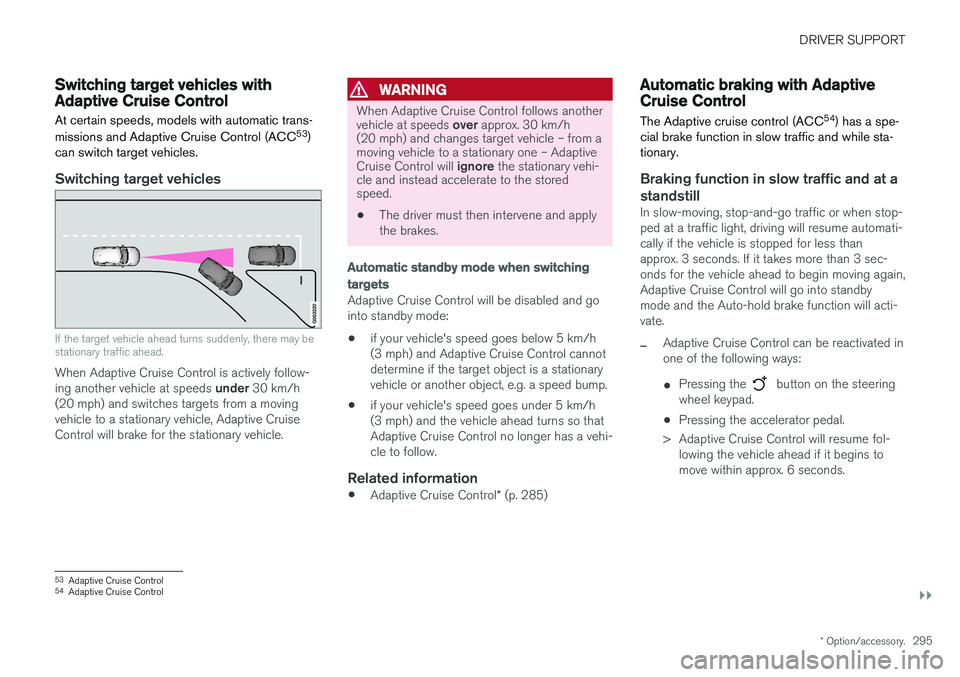
DRIVER SUPPORT
}}
* Option/accessory.295
Switching target vehicles withAdaptive Cruise Control
At certain speeds, models with automatic trans- missions and Adaptive Cruise Control (ACC 53
)
can switch target vehicles.
Switching target vehicles
If the target vehicle ahead turns suddenly, there may be stationary traffic ahead.
When Adaptive Cruise Control is actively follow- ing another vehicle at speeds under 30 km/h
(20 mph) and switches targets from a moving vehicle to a stationary vehicle, Adaptive CruiseControl will brake for the stationary vehicle.
WARNING
When Adaptive Cruise Control follows another vehicle at speeds over approx. 30 km/h
(20 mph) and changes target vehicle – from a moving vehicle to a stationary one – Adaptive Cruise Control will ignore the stationary vehi-
cle and instead accelerate to the stored speed. • The driver must then intervene and apply the brakes.
Automatic standby mode when switching
targets
Adaptive Cruise Control will be disabled and go into standby mode:
• if your vehicle's speed goes below 5 km/h(3 mph) and Adaptive Cruise Control cannotdetermine if the target object is a stationaryvehicle or another object, e.g. a speed bump.
• if your vehicle's speed goes under 5 km/h(3 mph) and the vehicle ahead turns so thatAdaptive Cruise Control no longer has a vehi-cle to follow.
Related information
•
Adaptive Cruise Control
* (p. 285)
Automatic braking with AdaptiveCruise Control The Adaptive cruise control (ACC 54
) has a spe-
cial brake function in slow traffic and while sta- tionary.
Braking function in slow traffic and at a standstill
In slow-moving, stop-and-go traffic or when stop- ped at a traffic light, driving will resume automati-cally if the vehicle is stopped for less thanapprox. 3 seconds. If it takes more than 3 sec-onds for the vehicle ahead to begin moving again,Adaptive Cruise Control will go into standbymode and the Auto-hold brake function will acti-vate.
–Adaptive Cruise Control can be reactivated in one of the following ways:
• Pressing the
button on the steering
wheel keypad.
• Pressing the accelerator pedal.
> Adaptive Cruise Control will resume fol- lowing the vehicle ahead if it begins to move within approx. 6 seconds.
53Adaptive Cruise Control
54 Adaptive Cruise Control
Page 298 of 674
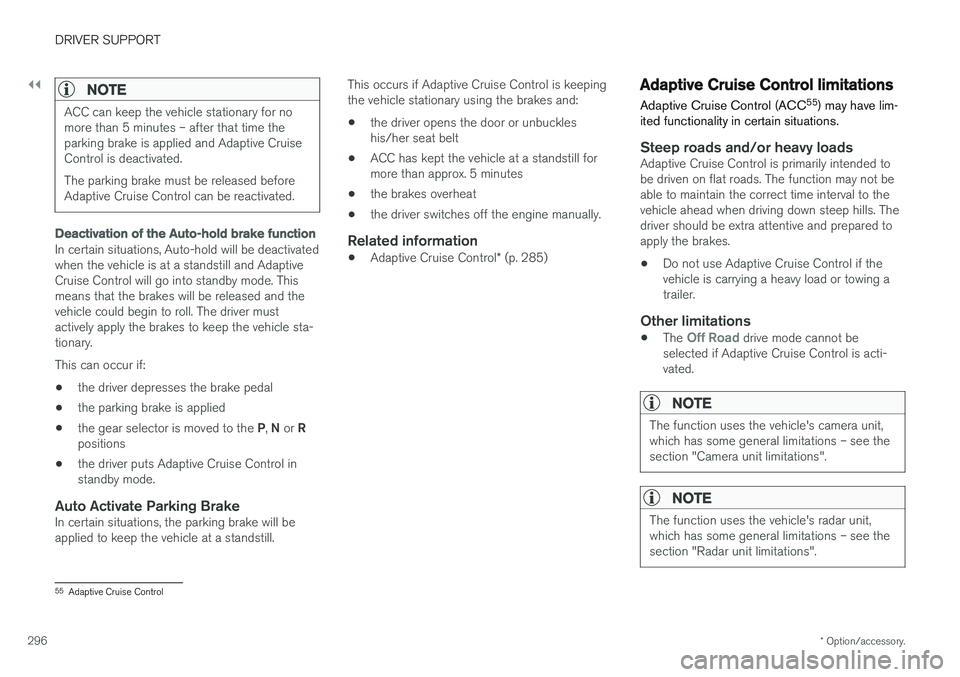
||
DRIVER SUPPORT
* Option/accessory.
296
NOTE
ACC can keep the vehicle stationary for no more than 5 minutes – after that time theparking brake is applied and Adaptive CruiseControl is deactivated. The parking brake must be released before Adaptive Cruise Control can be reactivated.
Deactivation of the Auto-hold brake function
In certain situations, Auto-hold will be deactivated when the vehicle is at a standstill and AdaptiveCruise Control will go into standby mode. Thismeans that the brakes will be released and thevehicle could begin to roll. The driver mustactively apply the brakes to keep the vehicle sta-tionary. This can occur if:
• the driver depresses the brake pedal
• the parking brake is applied
• the gear selector is moved to the
P
, N
or R
positions
• the driver puts Adaptive Cruise Control in standby mode.
Auto Activate Parking BrakeIn certain situations, the parking brake will beapplied to keep the vehicle at a standstill. This occurs if Adaptive Cruise Control is keepingthe vehicle stationary using the brakes and:
• the driver opens the door or unbuckleshis/her seat belt
• ACC has kept the vehicle at a standstill formore than approx. 5 minutes
• the brakes overheat
• the driver switches off the engine manually.
Related information
•
Adaptive Cruise Control
* (p. 285)
Adaptive Cruise Control limitations
Adaptive Cruise Control (ACC 55
) may have lim-
ited functionality in certain situations.
Steep roads and/or heavy loadsAdaptive Cruise Control is primarily intended to be driven on flat roads. The function may not beable to maintain the correct time interval to thevehicle ahead when driving down steep hills. Thedriver should be extra attentive and prepared toapply the brakes.
• Do not use Adaptive Cruise Control if thevehicle is carrying a heavy load or towing atrailer.
Other limitations
•
The Off Road drive mode cannot be
selected if Adaptive Cruise Control is acti- vated.
NOTE
The function uses the vehicle's camera unit, which has some general limitations – see thesection "Camera unit limitations".
NOTE
The function uses the vehicle's radar unit, which has some general limitations – see thesection "Radar unit limitations".
55 Adaptive Cruise Control
Page 302 of 674

||
DRIVER SUPPORT
* Option/accessory.
300
SymbolMessageMeaning
The symbol is WHITE. The vehicle is maintaining the set speed.
Adaptive cruise Unavailable
The symbol is GRAY. Adaptive Cruise Control is in standby mode.
Adaptive cruise Service required
The symbol is GRAY.
The system is not functioning as intended. Contact a workshop
‒ an authorized Volvo workshop is
recommended.
Windscreen sensor Sensor blocked, see Owner's manualClean the windshield in front of the camera and radar sensors.
A text message can be erased by briefly pressing the
button in the center of the right-side
steering wheel keypad. If the message persists: Contact a workshop ‒ an
authorized Volvo workshop is recommended.
Related information
• Adaptive Cruise Control
* (p. 285)
Page 303 of 674

DRIVER SUPPORT
}}
301
Pilot Assist
Pilot Assist helps the driver keep the vehicle in the current traffic lane by providing steeringassistance and maintaining an even speed and aset time interval to the vehicle ahead.
How Pilot Assist worksThe Pilot Assist function is primarily intended for use on highways and other major roads where itcan help provide a more comfortable and relaxingdriving experience.
The camera/radar sensor monitors the distance to the vehicle ahead and detects lane markings 61
.
Camera and radar sensor
Distance monitor
Lane marker line monitors The driver sets the desired speed and distance to the vehicle ahead. Pilot Assist monitors the dis-tance to the vehicle ahead and the traffic lane'sside markers using the camera and radar sensor.The system maintains the set time interval to thevehicle ahead by automatically adjusting yourvehicle's speed and keeps your vehicle in its laneby providing steering assistance. Pilot Assist's steering assistance is based on monitoring the direction of the vehicle ahead andthe traffic lane's side marker lines. The driver canoverride Pilot Assist's steering recommendationsat any time and steer in another direction, e.g. tochange lanes or avoid obstacles on the road. If the camera/radar sensor cannot detect the lane's side marker lines or if Pilot Assist is unablefor some other reason to clearly interpret thelane, Pilot Assist will temporarily deactivate steer-ing assistance until it can once again interpretthe lane markings. However, the speed and dis-tance warnings will remain active.
WARNING
Pilot Assist is deactivated automatically and resumes working without prior notice.
The color of the steering wheel symbol indicates the currentstatus of steering assistance: • GREEN indicates that steer- ing assistance is active • GRAY (as shown in illustra-
tion) indicates that steering assistance is deacti- vated.
61 Note: This illustration is general and details may vary depending on model.